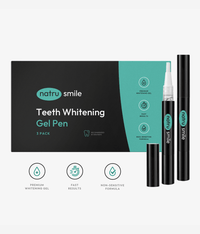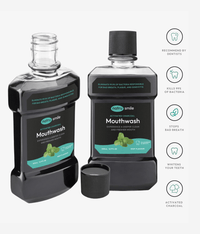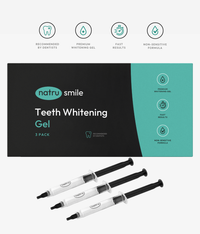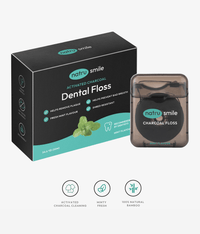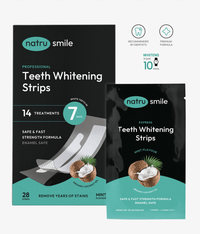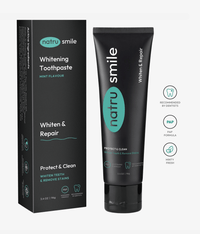
All products are certified by dental expert Dr. Greg Grillo
Perhaps you've thought of getting your teeth whitened, but are not ready for dramatic whitening procedures. Or maybe you’re worried about the potential risks of chemical whitening methods. If that's the case, you may want to consider enamel microabrasion as a way to get your teeth looking brighter and whiter without taking drastic measures.
Especially if you're looking for a mild whitening option or have sensitive teeth, this procedure could be the perfect choice. Keep reading to discover more about enamel microabrasion, what it involves, and the benefits of this mild dental treatment!
What Is Enamel Microabrasion: A Quick Look
Enamel microabrasion is a dental procedure used to correct minor surface irregularities, discoloration, and other damage to the teeth.
The treatment involves using a small amount of chemicals and an abrasive material, such as diamond dust or aluminum oxide crystals, to gently sand away small amounts of enamel from the tooth’s surface. It can help improve the appearance of your smile by removing staining and blemishes from the teeth without damaging them further.
In comparison to teeth whitening, it is a more mechanical rather than chemical procedure. As such, it’s much gentler on the teeth and gums. Think of it like this: it’s like removing wallpaper from a wall and sanding it down to prepare it for a fresh coat of paint.
In this case, the old wallpaper is your old enamel, while the sanding and prep process is to restore tooth enamel to give it a chance to shine again.
Who Is Enamel Microabrasion For?
Enamel microabrasion is typically used in less serious cases of tooth discoloration. Here are some of the most common reasons why people opt for this treatment:
- Mild to moderate cases of discoloration or staining
- Surface discoloration from smoking or consuming staining foods and drinks such as coffee, tea, and red wine
- Excessive fluoride use resulting in unsightly white spots on the teeth
- Minor enamel defects, such as pitted or eroded enamel
- Stains caused by certain medications, such as tetracycline antibiotics
- To remove some types of dental plaque and calculus (hardened plaque)
If you’re looking to make minor changes to your smile, enamel microabrasion is a safe and effective option. On the other hand, it’s not suitable for people with deep stains, severe enamel thinning, or large cavities. In these cases, other treatments, like veneers or crowns, may be recommended.
Is Enamel Microabrasion Healthy?
The good news is that enamel microabrasion is a safe and effective way to improve the appearance of your teeth. Studies show that microabrasion is considered a conservative treatment as the procedure doesn’t require any overly harsh chemicals, and enamel wear is minimal.
Any surface changes on the enamel that happen as a result of enamel microabrasion treatment are shown to be easily restored by saliva, testifying to the safety of the procedure. It’s important to note, however, that enamel microabrasion is only suitable for minor tooth discoloration. For more serious staining, you may need to consider other whitening options.
Enamel Microabrasion Procedure
Your dentist will begin the procedure by cleaning your teeth and removing any plaque and food particles. A protective gel will also be applied to protect your gums before any abrasive material is used. This helps ensure that your gums remain healthy during the process. In addition, your dentist will be able to accurately determine the amount of enamel that needs to be removed in order to achieve the desired result.
They’ll then use a special device to apply the abrasive and acidic material onto your teeth. The dentist will carefully work on each individual tooth, gently rubbing the material into the surface of the enamel in small circular motions. The abrasive action helps to remove staining and discoloration from the teeth by breaking up pigments that have become trapped in porous areas of enamel.
Once all of your teeth have been treated, the dentist will smooth your enamel out and clean your teeth with a sensitivity toothpaste.
Enamel Microabrasion Side Effects
The side effects of enamel microabrasion are typically minor. You may experience sensitivity in your teeth, but this should subside within a few days. It can also take some time for the outer layer of your enamel to rebuild itself and mineralize after the procedure.
In some cases, due to the abrasion of the enamel, the underlying dentin may make the tooth appear slightly yellow, but this can be addressed with a whitening agent.
How Long Does An Enamel Microabrasion Procedure Take?
An enamel microabrasion procedure typically takes no longer than an hour. During the appointment, your dentist will apply the abrasive material to your teeth and then use a special polishing tool to buff away any stains or discoloration. The results of enamel microabrasion treatment are usually immediate, although you may need more than one session depending on how much staining needs to be removed.
Enamel Microabrasion Before And After
Here’s a snapshot of what enamel microabrasion looks like before and after the procedure.
Before
Those with teeth that are slightly stained, discolored, or have minor surface irregularities may consider getting enamel microabrasion. Other common issues might include white lines or pits from dental fluorosis.
After
The procedure will leave the surface of your teeth glossy and shiny and not only help to improve the look of your teeth but the texture and feel as well. For example, it can help reduce tooth decay by smoothing out your enamel. This means that bacteria won’t be able to stick as easily, which can help prevent cavities.
Benefits Of Enamel Microabrasion
There are many advantages to getting enamel microabrasion. Here are a few:
- It’s an effective and safe way to remove surface discoloration and staining from your teeth, including those caused by smoking or drinking dark-colored beverages such as tea and coffee.
- The procedure is noninvasive, so that you won’t experience discomfort during the treatment or afterward.
- Enamel microabrasion requires no anesthesia, so it’s a great option for those who are afraid of needles.
- The procedure is relatively quick and requires no recovery time, making it a convenient choice.
- It offers long-term results since the mild abrasive material used will not damage the enamel in any way and won’t cause further discoloration or staining over time.
- It is typically more cost-effective than other teeth-whitening options
Downsides Of Enamel Microabrasion
Enamel microabrasion is a very safe procedure, but there are still some potential drawbacks to keep in mind.
- It’s not as effective at whitening teeth as other methods like bleaching or laser whitening.
- Depending on the extent of staining and discoloration present, more than one treatment may be needed to achieve your desired results.
- It isn’t suitable for internal staining and deep stains.
- It may reveal the yellow dentin underneath your enamel as the enamel surface will temporarily become thinner after treatment
Enamel Microabrasion Cost
Enamel microabrasion is generally more affordable than other teeth whitening or bleaching treatments. The cost of the procedure may vary depending on where you have it done and what type of materials are used, but on average, you can expect to pay anywhere from $75 to $150 for a single enamel abrasion treatment.
You can compare this to around $300 to $1,000 for Zoom whitening, $200 to $750 for take-home teeth whitening trays, and $400 to $1,800 for laser whitening.
Combining Enamel Microabrasion With Tooth Bleaching
Sometimes, enamel microabrasion is combined with tooth bleaching for a more effective way to achieve whiter teeth. Bleaching can be done at home or in the dentist’s office, but note that this type of treatment should only be done under professional supervision. The process involves applying a special bleaching agent to the surface of the teeth, which helps to break down discoloration and staining over time.
Curious to learn more about the enamel microabrasion process? Read on for some frequently asked questions.
Does Microabrasion Remove Enamel?
Microabrasion removes only a small amount of enamel from the tooth’s surface. The amount removed is so small that it can’t be detected with the naked eye and isn't enough to cause any damage or pain. This is key to the procedure, as the technique removes both the porous surface and the stains trapped inside it.
Is Enamel Microabrasion Permanent?
Enamel microabrasion is considered a permanent procedure in that the staining will not come back. However, it’s crucial to take care of your teeth and mind the kind of food and drinks you consume. Maintaining healthy and aesthetically-pleasing teeth can be maintained by following a good oral hygiene routine and avoiding foods that could cause staining or damage to the enamel.
Is Enamel Microabrasion Safe?
The procedure is safe and has minimal risks. It’s much gentler than teeth whitening, which uses powerful bleaching agents to remove staining. The biggest risk of enamel microabrasion is tooth sensitivity. But, this can be minimized by using the right type of abrasive material and having an experienced dental professional do the procedure.
Is Enamel Microabrasion Covered By Insurance?
Unfortunately, most insurance companies do not cover enamel microabrasion. Just like other dental procedures that focus on aesthetic needs, such as whitening and veneers, enamel microabrasion is generally considered an elective procedure.
Although unlikely to be covered, it’s always worth speaking to your insurance provider about the specific terms of your policy.
Does Enamel Microabrasion Work?
Yes, enamel microabrasion has shown to be effective for lightening teeth, and removing surface stains and discoloration. It can also help with minor chip or crack repairs. The results are usually immediate, and you should be able to see a noticeable improvement in the color and texture of your teeth right away.
One study has shown that employing at-home carbamide peroxide custom tray bleaching along with microabrasion can help to even out odd coloration patches after treatment. Another showed that the appearance of the teeth even improves over time as the tooth rebuilds itself.
But, don’t forget that this isn’t a suitable long-term solution for severe staining or discoloration. In those cases, you may want to consider traditional in-office teeth whitening options, veneers, or other cosmetic treatments.
Where Can I Get Enamel Microabrasion?
Enamel microabrasion is a relatively simple procedure, so you can find it at most dental practices. It’s a good idea to do some research on the dentist or hygienist performing the treatment, as different practitioners may have different levels of experience and expertise. You might not be qualified for the treatment either, depending on your teeth, which is why a consultation is usually required.
Is Enamel Microabrasion Painful?
As tooth enamel doesn’t have a nerve supply, there is no pain associated with microabrasion. As such, local anesthesia isn’t required, and steps are still taken to prevent tooth sensitivity. This might include covering the tooth with a fluoride paste or other techniques.
The fact that this process is painless also makes it suitable for children who have issues with marks and stains on their teeth. Instead of using a whitening toothpaste that can damage tooth enamel, a pediatric dentist can perform a microabrasion instead.
Final Thoughts
The best thing about dental procedures is that they can be tailored to the individual’s unique needs. If you want a more subtle approach to teeth whitening, enamel microabrasion is an excellent option. It’s relatively simple, painless, and can be done in just one visit to the dentist.
Plus, it’s much gentler on your teeth than other whitening procedures—so it’s perfect if you have sensitive teeth or are worried about potential side effects from bleaching agents. Overall, be sure to talk with your dentist about this procedure and discuss whether it's suitable for you before making any decisions!


